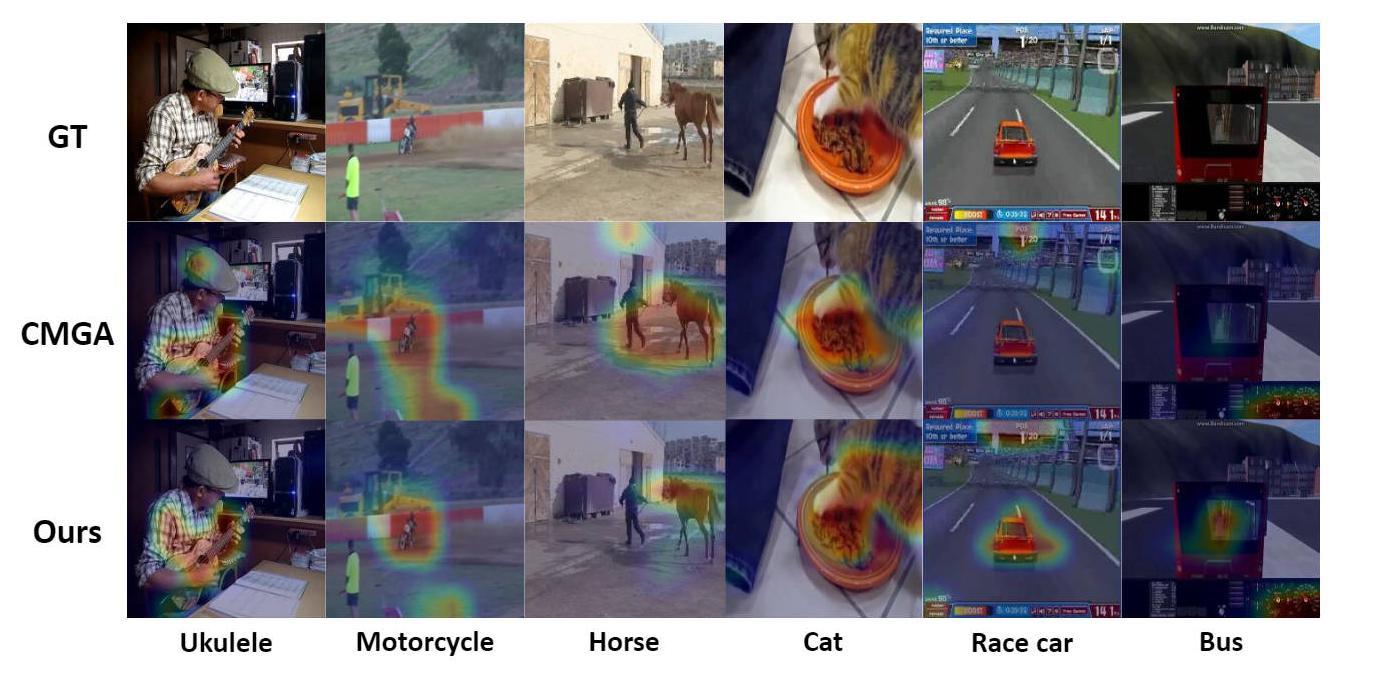Here is the PyTorch implementation of our paper.
Paper Title: "CACE-Net: Co-guidance Attention and Contrastive Enhancement for Effective Audio-Visual Event Localization"
Authors: Xiang He*, Xiangxi Liu*, Yang Li*, Dongcheng Zhao, Guobin Shen, Qingqun Kong, Xin Yang, Yi Zeng
Accepted by: MM '24: Proceedings of the 32st ACM International Conference on Multimedia
Figure 1: Method Overview showing the main components of CACE-Net.
This repository contains three folders, AVELCLIP, CACE, and Encoders, for Targeted fine-tuning, CACE-Net, and efficient encoders, respectively.
+---AVELCLIP # Targeted fine-tuning
| \---audioset_tagging_cnn
| +---checkpoints
| +---clip
| +---pytorch
| +---resources
| +---scripts
| \---utils
+---CACE # CACE-Net
| +---braincog
| +---configs
| +---data
| +---dataset
| +---model
| \---utils
\---Encoders # efficient encoders
\---audioset_tagging_cnn
+---pytorch
+---resources
+---scripts
\---utils
We highly appreciate @YapengTian for the shared features and code.
The AVE dataset is a subset of the AudioSet, which contains 4097 videos with a total of 28 event categories and 1 background category. The dataset can be obtained from https://drive.google.com/open?id=1FjKwe79e0u96vdjIVwfRQ1V6SoDHe7kK.
The AVE-ECCV18 repository offers the results of feature extraction from videos using the Vggish audio model pre-trained on the Audioset dataset and the Vgg-19 visual model pre-trained on the ImageNet dataset.
Note that the number of features here is 4143 instead of 4097 because a video may belong to different categories at the same time.
If you want to retrain yourself to verify the results in the paper, please refer to the commands in scripts run_aba.sh and run_supp.sh.
As an example, the script for using our method on the AVE dataset would look like this:
CUDA_VISIBLE_DEVICES=1 python supv_main.py --gpu 1 --lr 0.0007 --clip_gradient 0.5 --snapshot_pref "./Exps/Supv_supp/expLoss" --n_epoch 200 --b 64 --test_batch_size 64 --print_freq 10 --seed 3917 --guide Co-Guide --psai 0.3 --contrastive --Lambda 0.6 --contras_coeff 1.0 # This will get 80.796% accuracy, results in our paper.This took about 0.5h on a 40G-A100 GPU
We also provide model weights for the experimental results in the paper. The well-trained model can be found at here.
The script for validation can be:
CUDA_VISIBLE_DEVICES=1 python supv_main.py --seed 3917 --gpu 1 --test_batch_size 64 --guide Co-Guide --psai 0.3 --contrastive --Lambda 0.6 --contras_coeff 1.0 --evaluate --resume /home/hexiang/CACE/Exps/Supv_supp/expLoss_Seed3917_guide_Co-Guide_psai_0.3_Contrastive_True_contras-coeff_1.0__lambda_0.6/model_epoch_46_top1_80.796_task_Supervised_best_model_psai_0.3_lambda_0.6.pth.tarThe output results are as follows:
Loading Checkpoint: /home/hexiang/CACE/Exps/Supv_supp/expLoss_Seed3917_guide_Co-Guide_psai_0.3_Contrastive_True_contras-coeff_1.0__lambda_0.6/model_epoch_46_top1_80.796_task_Supervised_best_model_psai_0.3_lambda_0.6.pth.tar
2024-07-17 03:57:14,726 INFO
Start Evaluation..
2024-07-17 03:57:16,209 INFO Test Epoch [0][0/7] Loss 2.2928 (2.2928) Prec@1 75.000 (75.000)
2024-07-17 03:57:16,532 INFO ************************************************************************** Evaluation results (acc): 80.7960%.
2024-07-17 03:57:16,532 INFO completed in 1.81 seconds.Using the features provided in AVE-ECCV18 for comparison with other methods is a fair approach. If you want to further improve task performance, consider using more efficient encoders to extract features.
- Video frame extraction: We use
cv2.VideoCapture, please refer to the file visual_feature_extractor.py. - Audio file extraction: We use
moviepy, please refer to the file audioclip.py
- Visual Encoder: We use
ResNet50,EfficientNetis also ok. Please refer to the file visual_feature_extractor.py. - Audio Encoder: We use
CNN14, from PANN. Please refer to the file inference.py.
The commands for extracting audio features are as follows:
python inference.py audio_tagging --model_type Cnn14 --checkpoint_path /home/hexiang/Encoders/audioset_tagging_cnn/checkpoints/Cnn14_mAP=0.431.pth --audio_path="non.wav" --cudaIn efficient encoders, pre-trained models can be fine-tuned specifically for audio-visual localization tasks to obtain more generalized representations.
The fine-tuning script is shown below:
python main.py --batch-size 128 --dist-url 'tcp://localhost:10001' --multiprocessing-distributed --world-size 1 --rank 0| AVCA | BECE | Efficient Encoder | Accuracy(%) |
|---|---|---|---|
| - | - | - | 78.83 |
| ✓ | 78.93 | ||
| ✓ | 80.30 | ||
| ✓ | ✓ | 80.80 | |
| ✓ | ✓ | ✓ | 82.36 |
Figure 2: Visualization of different attention guidance methods.
If our paper is useful for your research, please consider citing it:
arxiv bibtex hereThis code began with CMRAN and CMBS, the code for the visualization is from AVE-ECCV18 and the implementation of SNN part is from Brain-Cog. Thanks for their great work. If you are confused about using it or have other feedback and comments, please feel free to contact us via hexiang2021@ia.ac.cn.
Have a good day !

